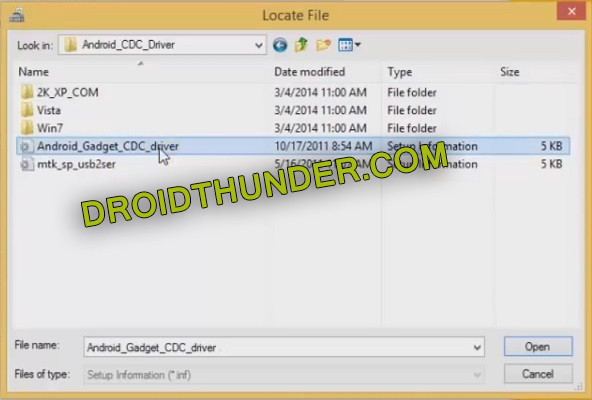Simple Steps To Install CDC USB Driver on Computer. Step 1: Download the ADB Driver from above download section. Step 2: Now, Extract the ADB folder on your computer. Step 3: Moreover, open the device manager and click on your computer or laptop name whatever it is. Step 4: This time, click on “Action” and then click on “add the legacy.
- Cdc Serial Driver Download Windows 8.1
- Cdc Serial Driver Download Mediatek
- Cdc Serial Driver Download
- Cdc Driver Driver Download Win 7
- Download CDC Driver Disclaimer: This file is completely free to use and distribute. All uploaded files and copyrights are properties of their respective owners.
- You can download the Android CDC driver 32 bit as well as download Android CDC driver 64 bit from the links given below. Most important, remember that this CDC driver is only compatible with Android phones powered by MediaTek MT65xx chipset. Furthermore, it is even compatible with MT66xx and MT67xx chipset.
- Android CDC Driver download on this page. If you want to use the SP flash tool, you might be installed Android CDC Driver. So, we added the androidcdcdriver.zip file to download on your windows computer. Manually Install CDC driver in your windows computer.
Android OS is the ultimate destination when it comes to the customization or flashing any file. There are plenty of tools and drivers available online that you can easily install on your PC/Laptop in order to start connecting your handset. But when it comes to the MediaTek chipset devices, there are a few and Android CDC Driver is one of them. Here in this guide, we will share with you the manual steps on how to download and install it on your computer in an easy way.
That means for the MediaTek device users, the CDC Driver will come in handy a lot in order to connect your Android smartphone with the computer. Once you install the driver on your PC, simply attach your device using the USB cable and you’re good to go. Now, you can either transfer data or flash firmware or any other file using the flashing tools.
What is the Android CDC Driver?
Here CDC means ‘Communications Device Class’ which is a Universal Serial Bus device class. It’s also known as CDC Serial Driver MTK (Mt65xx). This tool is developed by MediaTek and free-to-use. It fully works on Windows XP/Vista/7/8/8.1/10 version.



While generally, the USB Drivers allows the device system to transfer or sync device data with the connected computer or ADB commands to implement tasks. Meanwhile, if you want to flash the firmware file or any other third-party file on your MediaTek chipset running devices then you will require SP Flash Tool.
Download Link

Steps to Install Android CDC Driver {Manual Guide}
- Click on Start > Type Device Manager and select it.
- From the Device Manager page, click on Action.
- Next, click on Add legacy hardware.
- Click on Next from the wizard and follow the on-screen instructions.
- You have to select Install the hardware that I manually select from a list (Advanced).
- Now, click on Next > From Common hardware types section, click on Show All Devices.
- Click on Next > Browse and select the downloaded CDC driver file (inf).
- Finally, click on Open and then Next.
- You may have to select Install this driver software anyway if prompted.
- Wait for the installation process to complete.
- Once done, click on Finish to close the wizard.
- You’re done. Now, restart your PC and start using the CDC Driver.
Keep visiting the blog for more info.

Rootmygalaxy a.k.a RMG was started in 2015 with a solo goal of Helping users with easy How-to guides. Slowly the website started sharing exclusive Leaks and Tech News. In these 5 years, we have been credited by the likes of Forbes, CNBC, Gizmodo, TechCrunch, Engadget, Android Authority, GSM Arena and many others. Want to know more about us? Check out ourAbout Us pageor connect with us ViaTwitter, Facebook, YoutubeorTelegram.
-->Versions supported
- Windows 10
- Windows 8.1
Applies to
- Device manufacturers of CDC Control devices
Microsoft-provided in-box driver (Usbser.sys) for your Communications and CDC Control device.
In Windows 10, the driver has been rewritten by using the Kernel-Mode Driver Framework that improves the overall stability of the driver.
- Improved PnP and power management by the driver (such as, handling surprise removal).
- Added power management features such as USB Selective Suspend.
In addition, UWP applications can now use the APIs provided by the new Windows.Devices.SerialCommunication namespace that allow apps to talk to these devices.
Usbser.sys installation
Load the Microsoft-provided in-box driver (Usbser.sys) for your Communications and CDC Control device.
Note
If you trying to install a USB device class driver included in Windows, you do not need to download the driver. They are installed automatically. If they are not installed automatically, contact the device manufacturer. For the list of USB device class driver included in Windows, see USB device class drivers included in Windows.
Windows 10
In Windows 10, a new INF, Usbser.inf, has been added to %Systemroot%Inf that loads Usbser.sys as the function device object (FDO) in the device stack. If your device belongs to the Communications and CDC Control device class, Usbser.sys is loaded automatically.You do not need to write your own INF to reference the driver. The driver is loaded based on a compatible ID match similar to other USB device class drivers included in Windows.
USBClass_02
USBClass_02&SubClass_02
- If you want to load Usbser.sys automatically, set the class code to 02 and subclass code to 02 in the Device Descriptor. For more information, see USB communications device class. With this approach, you are not required to distribute INF files for your device because the system uses Usbser.inf.
- If your device specifies class code 02 but a subclass code value other than 02, Usbser.sys does not load automatically. Pnp Manager tries to find a driver. If a suitable driver is not found, the device might not have a driver loaded. In this case, you might have to load your own driver or write an INF that references another in-box driver.
- If your device specifies class and subclass codes to 02, and you want to load another driver instead of Usbser.sys, you have to write an INF that specifies the hardware ID of the device and the driver to install. For examples, look through the INF files included with sample drivers and find devices similar to your device. For information about INF sections, see Overview of INF Files.
Note
Microsoft encourages you to use in-box drivers whenever possible. On mobile editions of Windows, such as Windows 10 Mobile, only drivers that are part of the operating system are loaded. Unlike desktop editions, it is not possible to load a driver through an external driver package. With the new in-box INF, Usbser.sys is automatically loaded if a USB-to-serial device is detected on the mobile device.
Windows 8.1 and earlier versions
Cdc Serial Driver Download Windows 8.1
In Windows 8.1 and earlier versions of the operating system, Usbser.sys is not automatically loaded when a USB-to-serial device is attached to a computer. To load the driver, you need to write an INF that references the modem INF (mdmcpq.inf) by using the Include directive. The directive is required for instantiating the service, copying inbox binaries, and registering a device interface GUID that applications require to find the device and talk to it. That INF specifies 'Usbser' as a lower filter driver in a device stack.
The INF also needs to specify the device setup class as Modem to use mdmcpq.inf. Under the [Version] section of the INF, specify the Modem and the device class GUID. for details, see System-Supplied Device Setup Classes.
For more information, see this KB article.
Configure selective suspend for Usbser.sys
Starting in Windows 10, Usbser.sys supports USB Selective Suspend. It allows the attached USB-to-serial device to enter a low power state when not in use, while the system remains in the S0 state. When communication with the device resumes, the device can leave the Suspend state and resume Working state. The feature is disabled by default and can be enabled and configured by setting the IdleUsbSelectiveSuspendPolicy entry under this registry key:
To configure power management features of Usbser.sys, you can set IdleUsbSelectiveSuspendPolicy to:
Cdc Serial Driver Download Mediatek
'0x00000001': Enters selective suspend when idle, that is, when there are no active data transfers to or from the device.
'0x00000000': Enters selective suspend only when there are no open handles to the device.
That entry can be added in one of two ways:
Write an INF that references the install INF and add the registry entry in the HW.AddReg section.
Describe the registry entry in an extended properties OS feature descriptor. Add a custom property section that sets the bPropertyName field to a Unicode string, 'IdleUsbSelectiveSuspendPolicy' and wPropertyNameLength to 62 bytes. Set the bPropertyData field to '0x00000001' or '0x00000000'. The property values are stored as little-endian 32-bit integers.
For more information, see Microsoft OS Descriptors.
Develop Windows applications for a USB CDC device
If you install Usbser.sys for the USB CDC device, here are the application programming model options:
Cdc Serial Driver Download
Starting in Windows 10, a Windows app can send requests to Usbser.sys by using the Windows.Devices.SerialCommunication namespace. It defines Windows Runtime classes that can use to communicate with a USB CDC device through a serial port or some abstraction of a serial port. The classes provide functionality to discover such serial device, read and write data, and control serial-specific properties for flow control, such as setting baud rate, signal states.
In Windows 8.1 and earlier versions, you can write a Windows desktop application that opens a virtual COM port and communicates with the device. For more information, see:
Win32 programming model:
.NET framework programming model:
Cdc Driver Driver Download Win 7
Related topics
